The first time I rowed up the Inside Passage—from Washington’s Puget Sound to Prince Rupert, British Columbia—I used a long loop of line to pull the boat to and from the anchor during my stops on land. But it required an awful lot of line and wasn’t worth the trouble unless I was going to spend the night camped on shore. It wasn’t until I ended my trip that I was shown a better way. A native fisherman from Metlakatla, a Tsimshian village a few miles to the northwest of Prince Rupert taught me how the locals anchor their boats when they stop ashore. In 1987 I used the Tsimshian system frequently with my Gokstad faering on a second cruise up the Inside Passage. The anchor is ready to drop over the side with the retrieval line secured to the stock and the chain, rode, and painter joined to the shank.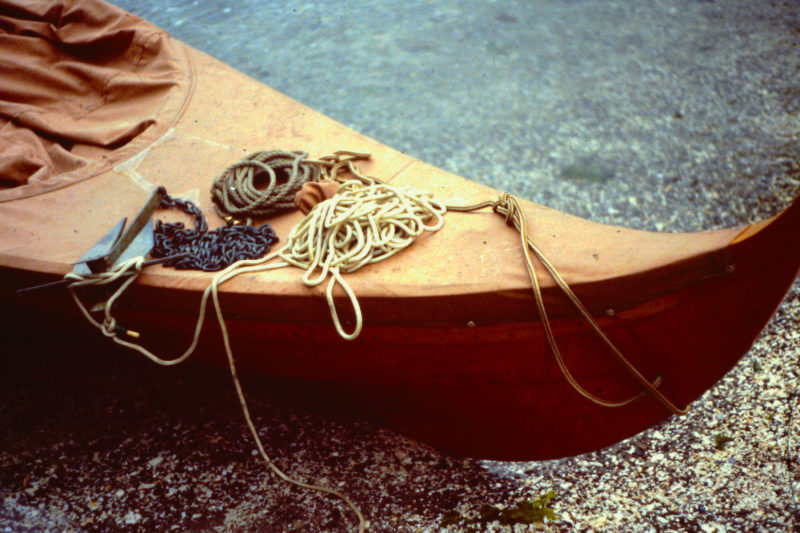 all photographs by the author
all photographs by the author
Join The Conversation
We welcome your comments about this article. To include a photo with your remarks, click Choose File below the Comment box.
Comments (12)
Comments are closed.

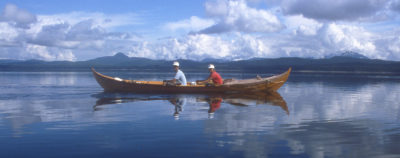
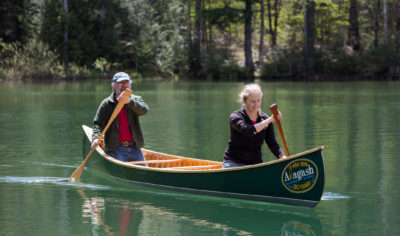
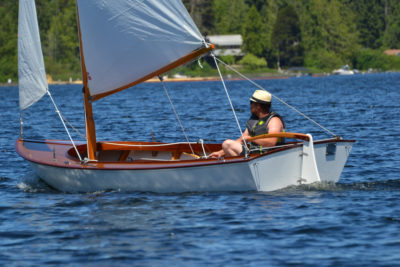

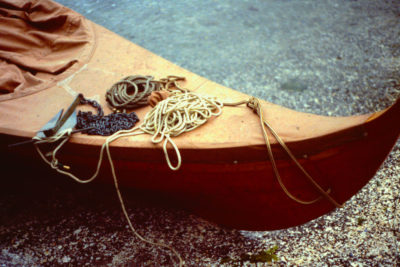
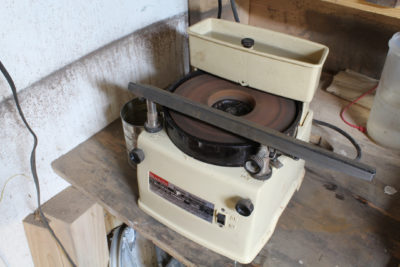
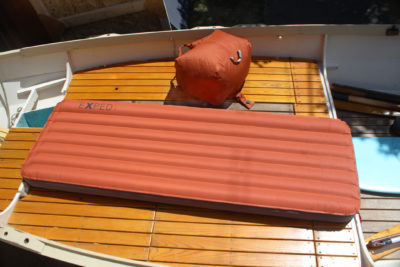

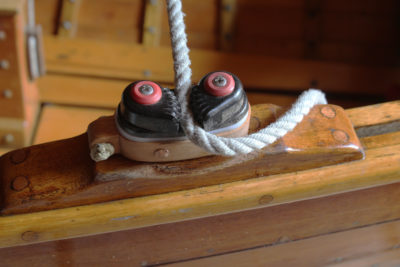
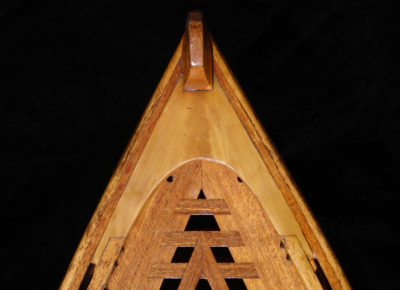
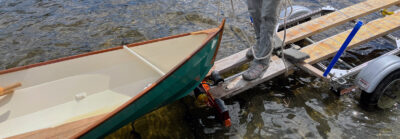

OK, Chris, I think I see how this works and that it would need only half the length of retrieval line as a clothesline rig. Seems like there might be a couple of issues, though:
1) How can you check the anchor set?
2) If you want to move the boat in and out (say loading food and cooking gear after dinner to send it out beyond the varmints), you have to retrieve the anchor also and then re-set it. Is that right?
That’s right, Rick, the retrieval line is half the length of the clothesline for the equivalent distance from shore. You can’t check the anchor set except by keeping an eye on the boat. If the anchor is dragging, the boat will still be tethered to shore and won’t go adrift, but you’d need to try again or consider other options. I’m picky about where I anchor my boat and look for coves that are well protected from wind and current. If there’s any doubt about the anchor holding, I’d keep an eye on the boat. For situations where you’re moving the boat in and out, you’ll need to repeat the process or set up a clothesline loop.
The fisherman who showed me the technique used it mostly for short stays ashore. His outboard skiff wouldn’t go far when he shoved it off the beach, but he’d have enough time for lunch breaks in places he could watch the boat. The faering could carry the momentum quite a distance so I could get it water deep enough for an overnighter. As you see in the photo, the time you have is limited my the distance the boat will coast and the range of the tide.
Thanks, Chris. With local 6’tides the clothesline or a shock-cord anchor works fine. If I get my dream of cruising (not racing) the Inside Passage, this method looks good.
Christopher, I have not had to anchor out much using canoes and kayaks, so the term “flaked the rode” isn’t familiar to me. I’m seeing this as “coils” of the rode or rope, then the chain with the anchor on top, right? On the small anchor that I carry on my 17-foot canoe, I have a poly line with a small float attached to one end and the other (my anchor retrieval line) to the bottom of the anchor to retrieve it with if it gets stuck or the rode/chain snagged on the bottom. Part of my anchor rode is a 15’ piece of bungee cord that will stretch to 45’. This, and more rode is attached to the bow is determined by the depth of the water at high tide. My boat retrieval line is attached to the stern. I drop the anchor going to shore and tie the boat to shore while unloading, then untie the boat retrieval line and the bungee pulls my canoe to deeper water. This only works well if the beach at low tide drops off steeply. On Hope Island two years ago, when the tide was out, it was a 200′ walk to the water. The boat had to be rolled down the beach on fenders, and then there were six trips with the gear. This is where your method would have shined well if I was sure it would not have been stolen over night. Using your method would have left my canoe in the channel at high tide and it would probably be missing in the morning, with a new owner claiming it as his own. I have never used the clothesline method; as you say, it includes a lot of rope. But moving everything back and forth, loading and unloading gets old fast. Then, there is always the dry-suit method discussed in the R2AK 2015 story that I read just before this one
In the photo of the faering’s foredeck the grey 3-strand rode is actually coiled, not flaked as the text indicated. The white braided retrieval line is flaked. Line that has been coiled can develop twists and kinks as it is pulled off; line that has been flaked doesn’t. Flaking is quicker than coiling, and while it looks messy, the line that is just piled up will run out freely as long as the pile isn’t disturbed.
Hi, Chris. I have been using your technique for small-boat anchoring since I was a kid in the ’50s in Falmouth, England. I understand it has been used for generations down in the West Country. The key I have found is to use a plough anchor and to secure the line to the ring one normally finds so that it does not get fouled under a rock. With the heavy seaweed we get, the anchor you use tends to just skitter over the top in the strong tide. Balancing the anchor on the stem-head makes for a better drop.
The boat I still use it on is an 8′ clinker punt, built by eye to the same design as that used over 100 years ago by the Pilot Luggers to transfer the pilot to sailing ships waiting off the Lizard and wishing to enter Falmouth Harbour. The design allows one to be towed and rowed in any sea and I have never shipped any water in rough weather.
Love your magazine, by the way. I’m starting on my next boatbuilding project shortly!
This is a great way to anchor and works well for my 14′ aluminum power boat. Quite a few of us use this technique here on Mudge Island (one of British Columbia’s Gulf Islands) but I did not know the source for the idea, so thank you.
I learned the same technique from Maine lobstermen. I wonder if Mainers brought it with them from England or thought of it independently.
Havilah Hawkins taught us this one. We do it with a rock though, and not overnight but just for a couple hours for a walkabout. I wonder if we’ve got enough gunwale on the dinghy to balance the anchor.
This anchoring method is used occasionally by sea kayakers. A sturdy mesh bag, the kind SCUBA divers use, filled with rocks, serves as an anchor. Loosely packed, it will drape over the bow of a kayak or the gunwale of a skiff and stay put until you pull the retrieval line.
That is a good method, Chris. I will try it out first chance. Normally I use Bruce anchors but a Danforth seems more indicated and I ordered one today. I did a lot of swimming in cold water to get out to my boat.
We have used this method for years on several different camp-cruiser sailboats while exploring ashore and not wanting to find ourselves neaped while gone. Never lost one to drift or theft.